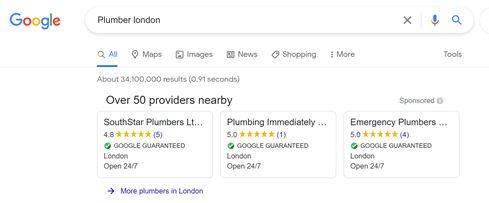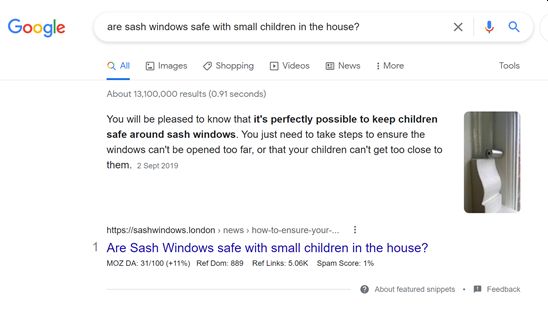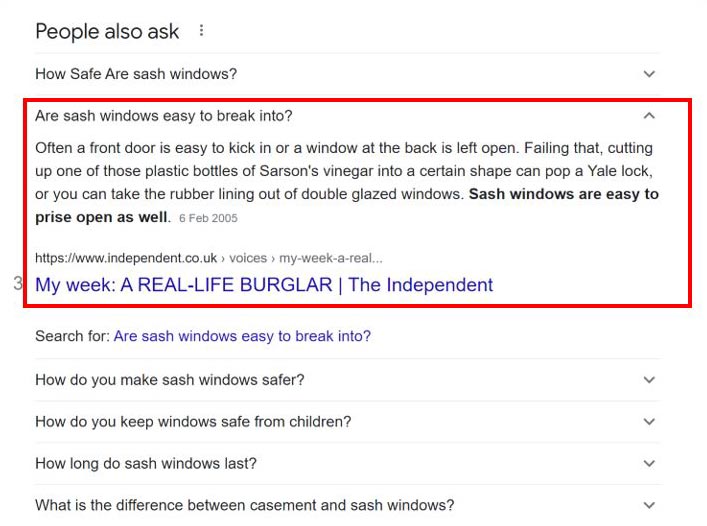Understanding Google’s algorithm and how it crawls, indexes and ranks trillions of web pages within the few seconds it takes to obtain results for a particular search is mind blowing. Thankfully, understanding the Google search results page is not so complex. We thought we’d summarise the basics, so you know and understand just what you’re looking at when Google responds to what you type in its search box.
When you head to Google’s homepage, the search box will appear. This is where you can enter your search query:

The next page that will appear is referred to as the search results page (you may be familiar with the term ‘SERPs’ which is simply an abbreviation for ‘Search Engine Results Pages’). What appears on the search results page will not always be the same as it will depend on the type of information you are looking for and the intent behind your search.
Google Local Service Ads
When a searcher enters a query into Google that encompasses a service-based keyword (such as ‘plumber near me’), local service ads are triggered and will appear at the very top of Google search results. Google Local Service Ads are a relatively new ad format and their main aim is to boost the visibility of service professionals online, help them gain new customers, book more jobs and grow a trusted online reputation within their local area. They work on a pay-per-lead basis.

Paid advertisements
Another common Google search feature is paid advertisements. Google ads will appear at the top of Google’s search results (but under Local Service Ads if triggered). Google paid ads are known as pay-per-click (PPC) ads and their prime positioning drive interested leads for the businesses that use them.
Paid advertisements are standard in search results with many companies running them for keywords that signify intentions to convert (or close to conversion). Keywords like “best place to buy plantation shutters near me” or “boiler repair services near me” tend to generate traffic that looks to make a purchase.

Organic listings
Organic listings are the most common feature in search results. They are deemed ‘organic’ as they are an unpaid for. Organic listings are natural listings of web pages that Google has crawled and deemed valuable for the search term entered in the search box. The more informative and valuable a webpage is around a keyword of key phrase; the higher Google will rank it in its results. Organic listings will direct you to a website and will typically have three core components attached to them – a title, a meta description and a URL:

Achieving a strong search engine organic listing for your website is a long game, but a game worth playing. Good search engine results will depend on such things as:
- The size of your website and how information-rich it is.
- How regularly your website is updated.
- If your website is optimised for search engines.
- Links to and from external, relevant websites.
Rich results are dependent on hundreds of influencing factors, but the ones outlined above will give you a good starting point as to what Google considers important when deciding which websites will rank higher than others.
Featured snippet
Featured snippets will appear as a block of text near the top of the search results before the other organic listings. However, they will only appear when Google finds a web page that directly and quickly answers the users search query. Featured snippets pull information from one of the organic listings and present it at the top of the results.
This is a very sought-after position since users tend to click on the first thing they see and for businesses, this is a great way to stand out from online competitors. The challenge is that there isn’t any set formular to follow when optimising your web pages to appear in the featured snippet. Your best bet is to create clear and concise content for your website that provides users with the information they seek, and fast.
For example, let’s say you’re trying to appear in the featured snippet for the question “are sash windows safe with small children in the house?” the answer that Google picked from its organic listings for this search term answers the question quickly and succinctly.

What is the ‘People Also Ask’ box?
The ‘People Also Ask’ box is a Google SERP feature that answers questions related to the user’s search query. Each answer comes from a web page, and there will be a clickable link to the web page source below each one. Unlike featured snippets, which usually appear either first or second in the search results, these boxes can appear in almost any position. Plus, the questions are seemingly infinite, and their formats vary.

Google’s local 3 pack

Google’s local 3-pack (sometimes known as the Map Pack) appears at the top of the local search results and lists three local businesses that fit the search query. It will only appear for users that conduct a local search. The aim of the 3-pack is to help drive local traffic for your business.
While there isn’t anything you can do that will guarantee you get in the local 3-pack, you can increase your chances of appearing in it by optimising your local listing. If you haven’t already claimed your local listing through Google My Business, you would do well to do this asap.
Getting your local business listed on Google will help you show up on Google’s search results when customers search for terms related to your business. Your listing will display all your important business information including contact details, location, and a direct to your website. You will also be able to post updates, add photos, and respond to reviews left by customers. A complete and comprehensive listing that is regularly updated boosts engagements on your local listing and is a great way to help you appear in the local 3-pack.
Hopefully, you now have a greater understanding of how Google search works and what features are likely to appear in Google’s search engine results page when you plug a question or query into the search box. If you would like any help improving the Search Engine Optimisation (SEO) of your website…give us a call, we’d love a chat.